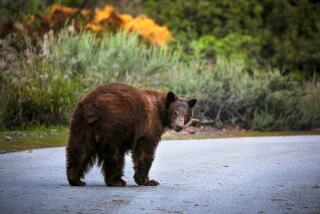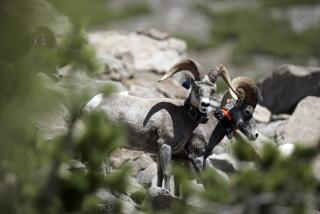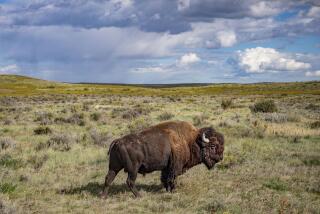Ranchers Have Few Discouraging Words About Raising Hardy Buffaloes : Revival: American bison prove easy to take care of. Their lean meat brings twice the price of beef and mountable heads sell for $400 on up.
- Share via
DENVER — There’s more capitalism than altruism these days behind the resurgence of the once nearly extinct buffalo--the shaggy animals are easier to raise, fetch more per pound and are lower in fat and cholesterol than beef.
The buffalo, which once roamed the Great Plains like a moving black robe, was hunted for meat and hides in such great numbers that historians say by 1889 fewer than 600 remained. Since 1970, the number of buffalo has doubled in this country to about 60,000, according to the American Bison Assn.
About 400 stockmen, ranchers like Brian Ward of Center, have gone into raising buffalo because of a beef market made unstable by American eating habits. Ward runs 1,700 head on his 100,000-acre spread in southern Colorado’s San Luis Valley and sells about 100,000 pounds of boneless meat a year.
“We get long winters in this valley,” he said. “The buffalo hide’s thicker (than cattle), they got a lot more hair and they eat and tend to be more like wild animals--store fat in the fall and their metabolism slows down in the winter, so they require less feed.
“There are some exciting times. We drive them about 35 miles to pasture and back every year, cross-country. We used to use horses but we use motorcycles now. The buffalo don’t charge the cycles as bad as they do horses.”
The price of good buffalo breeding stock has doubled in the last five years to about $1,500 for a young breed cow, twice what a comparable beef cow brings, according to the Denver-based ABA. But buffalo meat also brings twice the price of beef, and it’s lean meat. A 3-ounce serving has 93 calories, compared to 183 for beef; 43 milligrams of cholesterol, compared to 55 for beef; and 1.8 grams of fat, compared to 8.7 for beef, the association says.
A buffalo cow can bear calves for 30 years or more, while a cow is usually sent to slaughter after about 10. Stockmen can also sell skulls for $100 or so, uncured robes for $6 to $12 a square foot and mountable heads for $400 on up.
The symbol of the American West is an imposing animal. It has a black-brown, shaggy head and cape and short curved black horns. A mature bull stands more than 6 feet tall at its hump and weighs 2,000 pounds.
A century ago, the buffalo was nearly exterminated as the railroads pushed westward. The slaughter was triggered by demand for meat to feed the rail crews and the crowded East, a new tanning method that let the spongy hides be used as leather, and political expediency--to destroy the Plains Indians’ food supply.
Historian Francis Haines said: “The rush of new hunters to the Kansas plains resembled the stampede to a new gold strike. . . . In the spring of 1872 . . . the constant booming of the big guns sounded more like a battle than a hunt.”
In 1872, Col. Richard Irving Dodge wrote there was “apparently no limit to the number of buffaloes.” A year later, he found “myriads of carcasses. The air was foul with a sickening stench and the vast plain, which only 12 short months before teemed with animal life, was a dead, solitary putrid plain.”
Historians estimate that 6.3 million buffalo were killed in seven years.
The Plains Indians, whose society depended on the buffalo for food, shelter and clothing, either starved or surrendered. Their lives were so miserable that the “Ghost Dance” cult sprang up, preaching that whites would be buried and the buffalo would return. The Army’s massacre of 200 Sioux at Wounded Knee at the end of 1890 ended the “Ghost Dance” movement.
It wasn’t until the early 20th Century that buffalo preservation became a concern. The newly created American Bison Society and President Teddy Roosevelt were able to persuade Congress to set up preserves in Oklahoma and Montana in 1907. By then there were several hundred buffalo in private herds.
“It was the ranchers who really took it upon themselves to save the bison,” said Duane Lammers, president of the ABA. “Some of those early people who wanted to save the buffaloes had Indian heritage, some had Indian wives. It was very important to them to save the bison. . . .
“I think, too, it was just out of genuine care for them.”
Buffalo stockmen warn that the bison remains a wild animal, extremely powerful and territorial. There is an old saying that you can push a buffalo anywhere it wants to go. Another is never turn your back on a buffalo.
But the advantages are apparent as well.
“They are easier to take care of,” said Lammers, who runs about 1,000 head on his Triple Seven ranch in South Dakota.
“Beef producers are living with their cow herds during the calving season. That first spring when we didn’t have cattle we went through calving here with free time. It was like (taking) a couple of weeks off,” he said.
“If a storm comes up, I’m losing sleep over my cattle. With my buffalo, I can just sleep through the night.”
More to Read
Sign up for Essential California
The most important California stories and recommendations in your inbox every morning.
You may occasionally receive promotional content from the Los Angeles Times.










